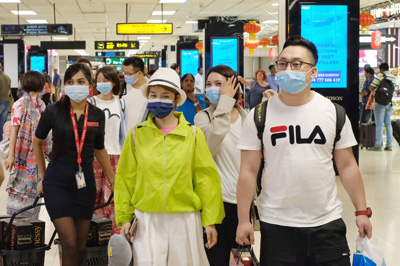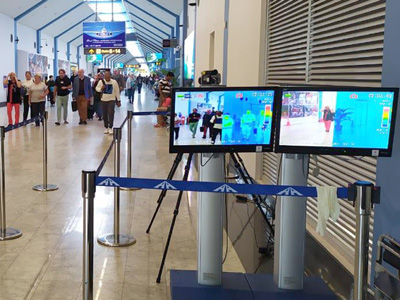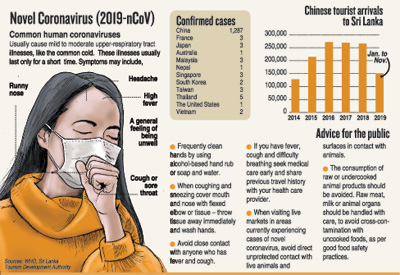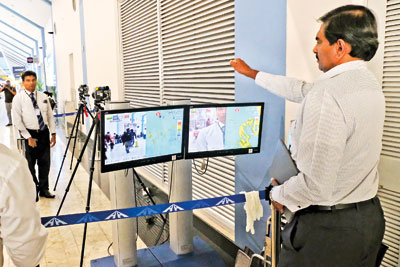News
2 Chinese tourists with suspected coronavirus admitted to IDH
Two Chinese tourists were admitted to the Infectious Diseases Hospital (IDH) yesterday with suspected coronavirus, Director Dr Hasitha Attanayake said.
A 43-year-old woman has arrived through a travel agent with a tourist group and had been in Ahungalla, at the tail end of her trip, when she came down with a fever, sore throat, cough and cold. She was conveyed to the IDH by her tour operator and a member of the Chinese Embassy had also been in touch, Dr Attanayake said, pointing out that preparedness and awareness on the ground was high.
Details were not immediately available for the second Chinese national who was admitted later yesterday.“Everyone is alert and there is no need for people to panic because that will make it worse,” he warned, adding that the Sri Lanka medical corps has decades of experience in managing such situations. The patient was hospitalised as she was from an epidemic area in China and her samples sent to the Medical Research Institute (MRI) for testing.
Earlier, a Chinese child was admitted but released after tests revealed that the affliction was not caused by coronavirus but a stomach bug. Two Indonesians also went through the system. One patient had influenza while the other was kept in isolation for having been exposed to the partner. Both tested negative for coronavirus and were discharged.

Scenes at the BIA airport on Saturday. Pix by Indika Handuwala and Amila Gamage
The IDH has isolation units for these patients. “When someone is admitted, we take the history and order the necessary investigations which aredone by the MRI in Borella,” Dr Attanayake said. “In consultation with those doctors, we arrive at a diagnosis.”
The coronavirus is new to the medical profession, he pointed out. “We need to enlighten our knowledge, experience and insight,” he explained. “It is under research at the moment. In the meantime, what we can do is isolate the patients, take precautions to control the spread of the virus, investigate and treat the patient.”
“The majority of cases are not bad,” said Dr Anil Jasinghe, Director General of Health Services (DGHS). “They recover. Very few get bad and they are mostly elderly.” The main concern is pneumonia and other respiratory complications.
The coronavirus has now reached South Asia with Nepal reporting its first case at the weekend. The infection originated at a seafood market in Wuhan, China. The World Health Organisation (WHO) was informed of “a cluster of cases of pneumonia” which later turned out to be a new strain of the virus that caused the SARS epidemic of 2002.
Since its identification, the virus has spread to Thailand, Japan, Beijing, Shenzhen, Shanghai, North America and Europe. By yesterday morning, the death toll had reached 41 and the total infected was 600. But fears of a repetition of the SARS epidemic resulted in swift action by the Chinese authorities.
A travel ban was put into effect in multiple cities, including Wuhan, which has been confirmed as “ground zero” of the virus. Celebrations to mark the Chinese New Year have been cancelled in an effort to curb the further infection of its peoples.
The Ministry of Foreign Relations said the Sri Lanka Embassy in Beijing “is closely monitoring the evolving situation of the coronavirus infection in China” and is presently in discussion with relevant Chinese authorities in Beijing and Wuhan as well as Sri Lankans in Wuhan and other parts of China.
The Embassy has been receiving queries from Sri Lankans in Hubei province, especially in Wuhan, as well as from their relatives in Sri Lanka. A WeChat group has been created by which the latest information is updated and information from Sri Lankans in Wuhan is received.
There are 25 to 30 Sri Lanka students in Wuhan Province in touch with the Embassy and they are safe, the Ministry said. The Embassy is in discussion with the Chinese authorities and other missions in Beijing to explore the possibility of evacuating Sri Lankans in Wuhan. 
All measures have been taken to ensure that the virus does not enter the country, Health Minister Pavithra Wanniarachchi said in Parliament on Friday. Official statistics show that 265,965 Chinese nationals travelled to Sri Lanka in 2018. Up to November last year, there were 151,215.
Air travellers are being advised to notify the relevant desks at the airport if they suffer the symptoms of the virus, she said. A dedicated medical team was deployed at the Bandaranaike International Airport (BIA).
The Airport and Aviation Services of Sri Lankan (Ltd) has also deployed hi-tech thermal scanners to detect patients who are running a temperature. These new machines were not the same that were used at the time of the SARS epidemic, said S. M. Arnold, Director of the Health Ministry’s Quarantine Unit. They are capable of detecting finer changes in body temperature whereas the old ones were not found to be particularly effective.
The National Civil Aviation Public Health Emergency Preparedness Plan (PHEPP), introduced in 2014, has been operationalised, said Bimal Dias, Senior Aviation Inspector/Aviation Medicine at the Civil Aviation Authority of Sri Lanka (CAASL).
“This has been put into action,” he said. “The staff have been briefed and trained and refresher programmes are taking place within the BIA, too.”
Several assumptions were made in the preparation of the PHEPP, which is available online. It is observed, for instance, that the warning period is usually relatively short should a novel virus emerge that is capable of efficient human transmission. It may take several days to confirm that it is a novel virus strain. The virus spreads quickly and may be associated with a high morbidity or mortality.

2 Chinese tourists with suspected coronavirus admitted to IDH
The PHEPP also assumes that Sri Lanka will be unable to prevent import or export of the novel virus or contain the spread of the disease in the community. However, the spread, import or export may be delayed through implementation of containment strategies including health control measures at points of entry, especially for air travellers.
A second wave occurs within three to 9 months of the initial outbreak and may cause more serious illnesses and deaths than the first. A third wave may occur (in the same year or a subsequent year). The length of each wave is about six weeks. There is initially no vaccine available. The development of a vaccine may take up to six months. When vaccines are eventually developed, the initial supply is limited and priorities have to be set for those to be vaccinated.
One of the key points in the PHEPP is the distribution of health declaration forms by respective airlines. SriLankan, the national carrier, said on Friday that it had implemented a series of “precautionary measures” to mitigate the risks from the coronavirus epidemic to safeguard both crew and passengers. Cabin crew and other employees have been briefed on what action to take on board the aircraft and at airports, particularly those in the Far East.
Temperature screening for arrival and departure travellers is another measure. They are set up at pre-designated sites. If individuals are recommended for further assessment at a hospital, then a dedicated ambulance service will ferry these potentially‐affected cases to the designated, the plan says.
“Ground handling agents shall retrieve the baggage of the passenger (and that of any accompanying person/s), ensure customs clearance and ferry the baggage to the ambulance pick up point,” it says. “There is no evidence to support the cleaning and/or disinfecting of baggage including items arriving from areas where a communicable disease has been reported. This would include the checked bags of a suspect case of communicable disease on board a flight.”
Dr Arnold urged the public to remain calm and follow instructions to support the authorities in prevention and control. “If you show signs of any respiratory illness, visit the nearest Government hospital and inform them of your travel history,” he urged. “Maintain good hand hygiene and thoroughly cook any food you consume.”
The WHO convened an emergency committee this week but its Director has said they were “undecided” on whether the situation constituted a public health emergency of international concern (PHEIC), a statement said.
In addition to providing care to patients and isolating new cases as they are identified, Chinese public health officials have reported that they remain focused on continued contact tracing, conducting environmental assessments at the wholesale market, and investigations to identify the pathogen causing the outbreak.
“Data collected through detailed epidemiological investigation and through the deployment of the new test kit nationally suggests that human-to-human transmission is taking place in Wuhan,” the statement observed. “More analysis of the epidemiological data is needed to understand the full extent of human-to-human transmission.”
Test kits are expected to be provided to all provinces, the WHO said. This will lead to further increases in the number of cases identified and confirmed in Hubei and other provinces. Increases in confirmed cases are to be expected as testing is increased.

